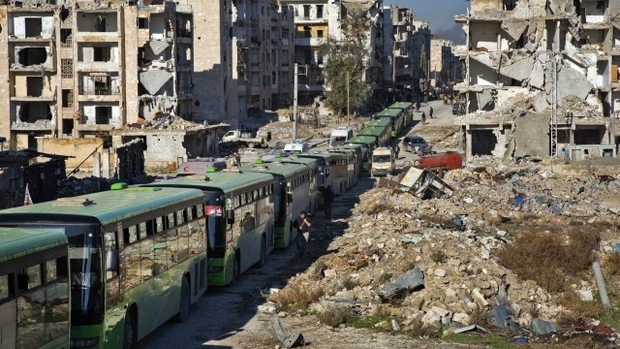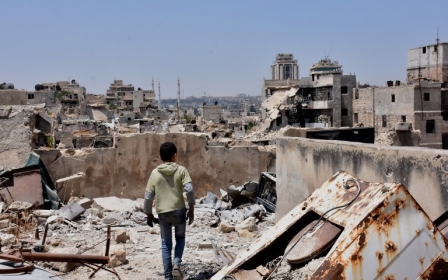'Nowhere to go': Thousands displaced from Aleppo fear same fate in Idlib

Having made it out of Aleppo alive, after years of a brutal siege, thousands of displaced Syrians are now having to contend with a Russian and Syrian government aerial campaign in Idilb, which is killing hundreds.
Many of the air strikes have taken place near densely populated internally displaced person camps in the Idlib countryside, where many live in squalid conditions.
But despite the area being part of a "de-escalation zone" deal, brokered by Iran, Russia and Turkey last year, the Idlib countryside has borne the brunt of the recent escalation in violence where major parts of the territory are controlled by the Islamic militant group Hayat Tahrir al-Sham (HTS).
The HTS umbrella grouping is not part of the de-escalation agreement.
Alarmed by the intensity of violence, the Red Cross on Thursday described the recent loss of civilians inside Idlib and elsewhere in Syria as the "most intense violence since the battle for East Aleppo".
"For the past two weeks, we have seen an increasingly worrying spike in military operations that correlates with high levels of civilian casualties," said the head of ICRC's delegation in Syria, Marianne Gasser.
'When I left Aleppo I knew something horrible was waiting for me in Idlib and of course the situation was no different'
- Abdulkafi Alhamdo, English teacher from Aleppo
Abdulkafi Alhamdo, who fled to the Idlib countryside to escape the violence in Aleppo, told Middle East Eye that the situation is worsening by the day.
"These massacres are increasing, with more attacks on civilian areas like hospitals and schools," Abdulkafi told MEE via Whatsapp.
Last Thursday, Syrian civil defence volunteers told Reuters that Russian and Syrian government air strikes had killed at least 150 civilians and injured dozens in over a week of continued bombing, with many being trapped under bombed out buildings.
And the UK-based Syrian Observatory for Human Rights dubbed September the deadliest month this year in the Syrian civil war, with more than 3,000 people killed including more than 900 civilians.
Having fled to Idlib in the last few days of the siege on Aleppo in late 2016, Alhamdo had hoped the security situation inside Idlib would be less dangerous than in Aleppo.
"When I left Aleppo I knew something horrible was waiting for me in Idlib and of course the situation was no different," said Alhamdo, a university lecturer and English teacher.
"Every time we hear a bomb blast my wife asks me what will happen. I have no answer to give her because I honestly don't know."
Khaled al-Ghasan, who was evacuated to Idlib from east Aleppo with his family shared Alhamdo's sentiments and said that people were afraid to leave their homes due to the increased bombardment.
"In the last three months of the siege in Aleppo, we were living under similar conditions of constant bombardment on schools and hospitals," said Ghasan.
"People are afraid to leave their homes and get on with their daily lives. They are bombing everything with all kind of weapons to try and make us leave, but where are we to go?"
Before rebels lost control of east Aleppo, Idlib was a relative safe haven and was rarely hit by air strikes.
But in one week alone in September, the Syrian Observatory for Human Rights estimated that more than 1,300 air strikes were fired upon 60 areas in Hama and Idlib by Russian and Syrian government warplanes, leaving at least 500 civilians dead, and hundreds more injured.
Some refugees who spoke to MEE fear the recent escalation in violence is part of a wider plan to eliminate any opposition to President Bashar al-Assad.
"It is clear that when the evacuations took place from East Aleppo, the regime wanted to corner its opponents into one place," said Talal Kaako, a former teacher who studied economics in Aleppo, who was resettled to the Idlib countryside after being forcibly displaced from east Aleppo.
'We left the nightmare in Aleppo only to relive the same horrors of airstrikes and bombs on schools in Jisr al-Shughor'
- Talal Kaako, teacher
"We left the nightmare in Aleppo only to relive the same horrors of air strikes and bombs on schools in Jisr al-Shughor.
"The situation is unbelievable and we have nowhere to go."
Ibrahim Halawi, who lectures in contemporary Middle East politics at Royal Holloway University in London, echoed Kaako's view that the evacuations of Syrians from east Aleppo was part of a wider "military strategy for the regime".
"The displacement strategy has served the regime's military strategy. There is little if any, reason not to adopt it in Idlib," Halawi told MEE.
"All relevant regional and international actors are distracted. Local rebels are disconnected and short on supplies as a result of distracted regional sponsors. This explains the timing of the new round of attacks."
With Idlib no longer safe, some have returned to government-controlled Aleppo, where fighting has subsided. Almost 290,000 people have returned to the formerly rebel-held east of the city since January, according to officials from the UN High Commission for Refugees.
Fadel Abdul Ghani, chairman of the Syrian Network of Human Rights, said on Wednesday that the Russians' aerial campaign in Syria was an attempt to force the population and rebels to surrender.
"Clearly, this is not about terrorism, it is about forcing a population to surrender or die," said Ghani.
"Just 15 percent of Russian attacks have targeted ISIS-held areas."
Russia has denied allegations that its air strikes have killed civilians in Idlib, saying that in recent days it had bombed militants in the area after they launched an offensive.
Moscow had committed to post observers on the edge of a de-escalation zone in Idlib, along with Iran and Turkey.
The move is part of a broader plan under which Moscow, Tehran and Ankara will set up four such zones in different parts of Syria, an idea described by critics as de facto partitioning of the war-torn nation.
Last month, the three nations had agreed on details of the plans to set up de-escalation zones in Syria for six months, negotiators for the three nations said in a joint statement.
The zones will include Eastern Ghouta, the provinces of Idlib, Homs, Latakia, Aleppo and Hama, according to the statement. The six-month term, which was agreed after talks in Kazakhstan's capital Astana, may be extended in the future.
Additional reporting from Zouhir al-Shimale in Turkey.
Middle East Eye propose une couverture et une analyse indépendantes et incomparables du Moyen-Orient, de l’Afrique du Nord et d’autres régions du monde. Pour en savoir plus sur la reprise de ce contenu et les frais qui s’appliquent, veuillez remplir ce formulaire [en anglais]. Pour en savoir plus sur MEE, cliquez ici [en anglais].






